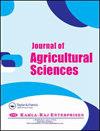Developing a Machine Vision System to Detect Weeds from Potato Plant
IF 0.7
Q3 AGRICULTURE, MULTIDISCIPLINARY
引用次数: 6
Abstract
crops, different weeds grow along with potatoes in agricultural fields. These weeds reduce the performance of crops due to competing with them to absorb water, light, and nutrients from soil. Accordingly, in this study, a machine vision system with the hybrid artificial neural network-ant colony algorithm (ANN-ACO) classifier was developed for a site-specific spraying considering the weed type. Potato plant and three weed types including Chenopodium album, Polygonum aviculare L., and Secale cereale L. were used in this study. A digital camera (SAMSUNG WB151F (CCD, 14.2 MP, 30f/s) was placed in the center of the video acquisition system. The distance between plants and the digital camera was fixed at 40 cm. For video acquisition, only lamps of white LED with a light intensity of 327 lux were selected. For filming in order to evaluate the proposed system, a 4-hectare area of Agria potato fields in Kermanshah-Iran (longitude: 7.03°E; latitude: 4.22°N) was selected. Employing the Gamma test, among 31 features, 5 features (Luminance and Hue corresponding to YIQ color space, Autocorrelation, Contrast, and Correlation) were selected. The correct classification accuracy for testing and training data using three classifiers of the hybrid ANN-ACO, radial basis function (RBF) artificial neural network, and Discriminant analysis (DA) was 99.6% and 98.13%, 97.24% and 91.23%, and 69.8% and 70.8%, respectively. The results show that the accuracy of DA statistical method is much lower than that of the hybrid ANN-ACO classifier. Consequently, the results of the present study can be used in machine vision system for the optimum spraying of herbicides.马铃薯杂草的机器视觉检测系统研究
农作物,不同的杂草和土豆一起生长在农田里。这些杂草由于与它们竞争从土壤中吸收水分、光和养分而降低了作物的产量。基于此,本研究基于混合人工神经网络-蚁群算法(ANN-ACO)分类器,开发了一种针对杂草类型的定点喷洒机器视觉系统。以马铃薯植物为研究对象,以藜、蓼、禾鳞3种杂草为研究对象。在视频采集系统的中央放置一台数码相机(三星WB151F, CCD, 14.2 MP, 30f/s)。植物与数码相机之间的距离固定为40厘米。视频采集只选择光强为327勒克斯的白光LED灯。为了评估拟议的系统,在Kermanshah-Iran的一个4公顷的Agria马铃薯田(经度:7.03°E;纬度:4.22°N)。采用Gamma检验,从31个特征中选择5个特征(YIQ色彩空间对应的Luminance和Hue、Autocorrelation、Contrast和Correlation)。混合ANN-ACO、径向基函数(RBF)人工神经网络和判别分析(DA)三种分类器对测试和训练数据的正确分类准确率分别为99.6%和98.13%、97.24%和91.23%、69.8%和70.8%。结果表明,DA统计方法的准确率远低于ANN-ACO混合分类器。因此,本研究结果可用于机器视觉系统中除草剂的最佳喷洒。
本文章由计算机程序翻译,如有差异,请以英文原文为准。
求助全文
约1分钟内获得全文
求助全文
来源期刊

Journal of Agricultural Sciences
AGRICULTURE, MULTIDISCIPLINARY-
CiteScore
1.80
自引率
0.00%
发文量
0
 求助内容:
求助内容: 应助结果提醒方式:
应助结果提醒方式:


